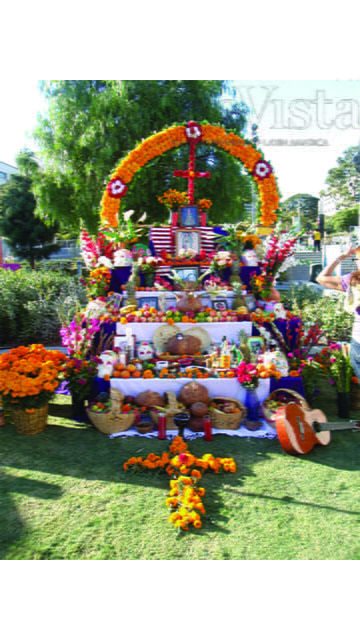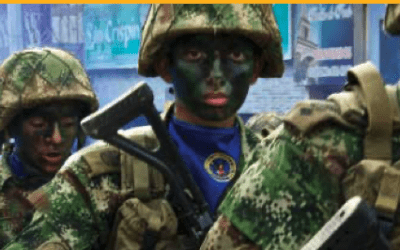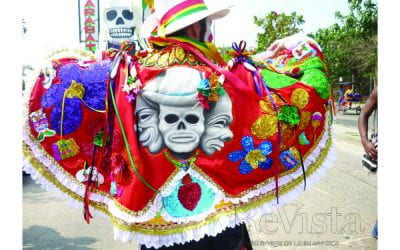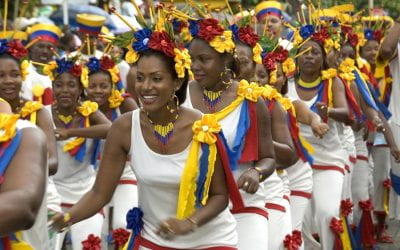Death in L.A.
Días de los Muertos, a Living Celebration
Photos by Emmanuel Sandoval
I was a Chicano boy growing up Apostolic-Pentecostal in Los Angeles. I never celebrated anything remotely Catholic like the feasts of All Souls nor All Saints. ¡Dios nos libre! (God forbid)—God keep us from anything as pagan-demonic as the Aztec gods of death, such as Día de los Muertos. My first experience of this holiday was far from Los Angeles; hoping that no one would notice me at a Day of the Dead celebration, I was trying to hide somewhere along the streets of San Francisco’s Mission District. Now, the celebration has spread throughout the United States, expanding beyond its Chicano-Catholic roots. In San Antonio, Texas, residents flock to the local cemeteries where mariachi bands play by gravesites, while families of loved ones clean tombstones and eat homemade tacos on the grounds. Denver, Colorado, recently hosted an exhibit on the work of legendary artist José Guadalupe Posada who brought the Mexican calaveras (skulls) and calacas(skeletons) to life. Chicana/o and Latin American artists across the Southwest have long participated in these celebrations, producing a variety of cultural artifacts. Many of these artists attended U.S. colleges and are now producing, importing and transporting art, culture and intelligence of this history beyond the southwestern United States or Aztlán. Activist students have been the conduits of art, and songs like “La Bruja” (the witch) and dances by student ballet folclóricos in places like the University of California Berkeley, UCLA, Stanford, and even by the the Harvard Ballet Folclórico de Aztlán.
In fact, it was at Harvard in Adams House that I made my first Day of the Dead mask (máscara) in a workshop led by Luz Herrera, a fellow Chicana student at Harvard Law School, who had learned how to make máscaras as a Stanford undergraduate. In 1996 at Harvard, I organized my first procession of students, wearing calaveras and holding candles, with student Aztec Danzantes cavorting through the Cambridge streets. Marchers walked behind them, clapped and cheered, chanting “La raza vive” (“The [Chicano] people live”) and “La lucha sigue” (“The fight continues”).Seventy marchers moved through the streets, ending up at the Harvard Divinity School, where together we built my first altar inside Anderson Chapel in collaboration with the LGBT and Latino student groups; Pancho Villa and Emiliano Zapata’s images were propped next to Harvey Milk, and Tejana-superstar Selena’s pic stood between Audre Lord and James Baldwin.
It was authentic celebration, made their own by Harvard students. But others also have tried to appropriate this increasingly popular festivity. In Los Angeles, the Walt Disney Company recently tried trademarking Día de los Muertos (which I will refer to as Días de los Muertos, plural, because this celebration has always been more than one day). Immediately, Latina/o activists fought back on social media. Insulted, activists let Disney know this holiday, “Días de los Muertos,” was not for sale; it did not have a price tag; this was our collective sacred calavera. For decades, masses of Angeleno children and grandparents showcasing painted faces have commemorated days of death as a two-month celebration of life, starting in late September though early November with street festivals, hole-in-the-wall galleries, exhibitions, concerts and large public processions. In L.A., Días de los Muertos is celebrated in the mainstream across the variety of social strata, divergent venues and spaces which range from the public downtown and commercial stores to the private, communal and sacred other.
The festival of Días de los Muertos spreads across L.A., from the more affluent Westside at Hollywood Forever Cemetery, where Marilyn Monroe is buried, to the city’s Latino blue-collar Eastside at Rose Hills Memorial Park and Mortuary, where for years now the Cultural Festival and Marketplace take place. Events in Downtown L.A., La Placita on Olvera Street, Uptown Whittier, the nation’s largest celebration at Self-Help Graphics in the Boyle Heights neighborhood and in a diversity of locations cover the entire L.A. basin. These events and dozens more attract hundreds of thousands of spectators to the altar exhibitions for a social cause such as the American Diabetes Association or commercially assembled by a corporation such as Goya or Nestle’s Chocolate Abuelita. Children and parents flock to have their face painted with calavera-adorned Mexican-Chicana/o motifs. Art exhibits feature prolific Chicana/o artists like Yolanda Gonzalez, Lalo Alcaraz and Hector Silva, as well as children’s crafts, market wares, food zones, performance stages, altar contests and many other attractions. At most commemorations of Days of the Dead, spectators represent a broad swath of the community, everyone from white to Chicano hipsters, also called Chipsters, wearing fancy painted Marilyn Monroe-themed calaveras or a simple self-painted Rosie the Riveter calavera, often including a character outfit to match a glamorous Elvis face or simply a flower over an ear for the Frida Kahlo or Betty Page; it’s in proximity to Hollywood after all. Any character within the imagination is brought back from the dead to live and celebrate with the living at this festival.
“I grew up observing Día de los Muertos by going across the border to the Mexican cemetery where both of my parents had family buried, several generations of family members. We’d clean up the tombstone and gravesite, tie flower arrangements and walk around as my mother pointed out long-gone relatives,” said Macarena Hernandez, a professor at the University of Houston-Victoria, who has written about Day of the Dead. “The first time I saw Día de los Muertos as a community-wide celebration was in San Francisco when I was in my first year as a graduate student at UC Berkeley. I remember feeling so detached from the celebration, because up until then, it had been a very private family commemoration.” This year, Hernandez made her first public altar, dedicated to her maternal grandmother, at the NAVE Museum in Victoria, Texas. This experience is not new for me; I’ve been making public altars ever since that first one at Harvard. Years ago, with my students at CalState University Northridge, we dedicated a public altar in memory of Marco Firebaugh and the Dreamer students he fought so hard for during his life. This year my altar was dedicated to “Dead Divas,” including Celia Cruz, Whitney Houston, Selena, Amy Winehouse, Jenny Rivera, Chavela Vargas and a very dear friend Jorge Herrera, a fellow Apostolic and Cal grad too. Across L.A., individuals and community organizations build personal and public altars in sacred spaces, such as their homes. Some businesses paint windows with calaveras as they would paint Frosty the Snowman during Christmas.
THE BIRTH OF DEATH AND THE ORIGINS OF DAYS OF DEAD IN MESOAMERICA
Ironically, U.S.-style Halloween is celebrated widely in Mexico and Latin America, with “All-things-American” dominating the October 31 holiday. Commonly worn are Halloween-type costumes, like witches and jack-o-lanterns. Even trick or treating has quickly spread across Latin America. However, many countries celebrate both Días de los Muertos and Halloween—sometimes forgetting their origin in Mesoamerica’s celebrations of the lives of defunct relatives and heroes. The Pre-Colombian and pre-Hispanic Aztec-Nahuas, Purepechas (of modern-day Michoacán), Mixtecas, Zapotecas, Oaxaqueños and other indigenous cultures of Mesoamerica observed several Days of the Dead before 1492. The Mesoamerican axis-mundi or world centering enjoyed a complex view of life and death as a duality, as the opposite sides of a coin, male and female, light and darkness, Ying and Yang. From a Mesoamerican perspective, the dead and the living were symbiotic, the living learned from the dead and their experiences and the dead needed guidance from the living to help them transition into finding their resting place, Mictlan (Aztec underworld). Marcos Aguilar, the Tlayecantzi (Aztec) Principal of Anahuacalmecac International University Preparatory High School of North America in L.A., reminds us of the Days of the Dead didactic when he says, “Micailhuitl is the name for our traditional honoring of the passing of life from physical to essence. In our ancestral traditions, we do not only honor people who have passed away, but all natural life that makes up the great mystery of the world and universe. This is a cultural ceremony that helps teach our children about the natural laws of life as understood by our ancestors.”
ANGELS OF DEATH: POLITICS, VOTER REGISTRATION AND CAUSES DU JOUR IN LOS ANGELES
Días de los Muertos has taken on other and very contemporary meanings. Death lives on in L.A. Often the high price of political silence, civic non-participation, social alienation, environmental discrimination and economic underdevelopment can mean life and death. In the 20th century José Guadalupe Posada, from the Mexican state of Aguascalientes, armed with pen, paper and political satire, transformed the calavera, giving birth to a new Mexican political reality. Through his most famous character “La Catrina,” the mother of all calaveras, Posada mocked the dark mestizos like Porfirio Diaz, a president well known for denying his indigenous peasant roots preferring to pass for European. Posada poked fun at Mexican society with satire.
Today in L.A., artists transform the social, economic and cultural landscape armed not with guns and bullets, but with brushes, paint, skills and talent. “I personally celebrate by first and foremost making an altar as traditional as possible. I start with the children and then the adults,” said Lilia Ramirez. “I also paint and make Día de los Muertos jewelry, art, and handmade crafts. Related themes such as: spiritual, love, daily interactions, familiar Mexican iconography, scenes and urban landscapes. I make costumes and dress up within the theme of Días de los Muertos and participate at various Day of the Dead venues.”
Another community activist, Sandra Figueroa-Villa, works at El Centro Del Pueblo, a local non-profit organization that has transformed the urban core through youth programs, dance and culture, jobs and social services. Like Figueroa-Villa, thousands of mothers, community activists, businesswomen and soccer moms continue this familiar Posada tradition of painting L.A.’s urban canvas with their broom, pushcart business, minivan, a brush or pen. Festivities take on a didactic form to paint murals, register youth to vote and share public policy activism by speaking at city hall. As calaveras presented Posada with a conduit for transformation of ideas, today in L.A. Días de los Muertos offers an opportunity to celebrate life, transform community and all the culture, social and political satire for the entertainment capital of the world.
I must confess: Días de los Muertos has become my favorite holiday and this celebration lives on immortally in the City of Angels.
Spring 2014, Volume XIII, Number 3
Felipe Agredano-Lozano holds a Master’s in Theological Studies from Harvard Divinity School (1997) and was a former DRCLAS intern. He resides in the City of Angels and has taught on Chicanos and Religion at Harvard University, CalState University Northridge and World Religions at East LA College. He often appears in national networks such as: CNN Español, Univision, NBC/Telemundo and is quoted in the LA Times, Wall Street Journal and La Opinion. To contact Felipe LIKE: facebook.com/TeologoFelipeAgredano or e-mail: felipe_agredano@post.harvard.edu
Related Articles
Festival and Massacre
Festivals are privileged spaces to help us understand the meaning of community. They are a special way of presenting historical narratives, bringing…
Fiesta and Identity
English + Español
In Barranquilla the days of Carnival begin early. From the first hours of the day—already confused with the last hours of the night—the smells of celebration are in the air. The streets…
Fiestas: Editor’s Letter
At the Oruro Carnival, a few hours from La Paz, the heavy-set blue-skirted women swirl past me in a dizzying burst of color and enviable grace. The trumpeters, some with exotically dyed hair, blare not too far behind. I remember that as a young man President Evo Morales had been a trumpeter in this very carnival.





